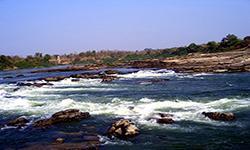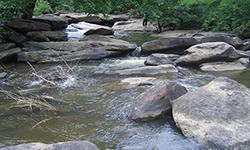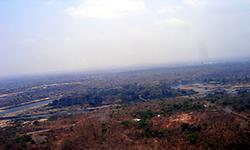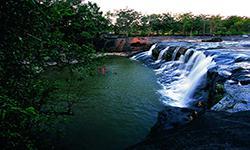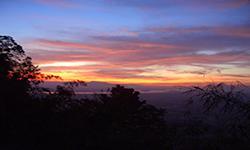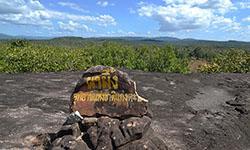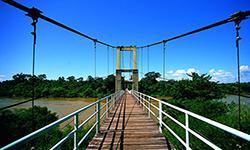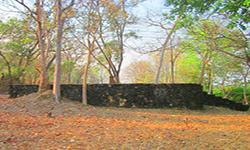Kaeng Tana National Park
Contact Location : Kaeng Tana National Park, PO Box 6, Khong Chiam District, Ubon Ratchathani Province 34220
Telephone Number : (+66 ) 4 525 2722 – 3 Fax: (+66) 4 525 2723
Email : kaeng_tana2012@hotmail.com, somchaikurmanee@hotmail.com
Facebook : Kaeng Tana National Park
Information
Kaeng Tana National Park is located in Khong Chiam and Sirindhorn District, Ubon Ratchathani Province. The general condition of the area is plains and low hills with Khao Banthat peak as the highest point, the altitude is about 543 meters above mean sea level. The Mun River and the Mekong River flow along the northern border of Laos. Within the Kaeng Tana area, there are deep and rapid streams and many underwater caves. Therefore, there is abundant fish. There are big rocks in the middle of the streams. The area is about 50,000 rai or 80 squared well-lane.
Background
Background: The Royal Forest Department issued a letter No. Ko So 0706/2967 2967 dated February 21, 1974 regarding selection of areas for establishing wildlife sanctuaries and national parks and requiring the Regional Forest Offices to conduct the investigations over the forests in each region to determine which areas are suitable for establishing as wildlife sanctuaries or National Parks. From the survey, Ubon Ratchathani Provincial Government sent a letter no. O Bo 09/24531 dated December 2, 1974 to the Ubon Ratchathani Regional Forest Office, stating that Dong Hin Kong Forest in the area of Khong Chiam Sub-district, Khong Chiam District has an suitable area for establishing as a national park.
Therefore, the Ubon Ratchathani Thani Regional Forest Office has a letter no. Ko So 0809 (O Bo)/1799 dated August 7, 1975 informing the Royal Forest Department that the survey found that Dong Hin Kong Forest is fertile and has many beautiful natural things. But it is under a forest project for the multi-purpose use of the people of Ubon Ratchathani Province and the Ubon Ratchathani Thani Forest Office therefore considered that it is appropriate to designate some areas of the Dong Hin Kong Forest around Kaeng Tana and Tat Ton Waterfall an area is approximately 12 square kilometers, to be a forest park.
The Royal Forest Department issued an order No. 710/2521 on April 25, 1978 for Mr. Nopporn Saengsida, a Forestry Technical Officer 4, to conduct a preliminary survey of the said area to establish a national park. According to a survey report of the Ubon Ratchathani Regional Forest Office No. Ko So 0809/ (O Bo.)/2730 dated August 14, 1978, Dong Hin Kong Forest is an upstream forest of the Mun River. There are beautiful natural features suitable for setting up a national park.Intiailly, the Royal Forest Department issued an order 2428/2522 dated December 7, 2522, for Mr. Sangam Chancham, a Forestry Technical Officer 4, to establish a Dong Hin Kong Forest Park.
Subsequently, Dong Hin Kong Forest Park issued a letter No. Ko So 0708 (Do Ko) / 11 dated March 5, 1980 stating that it surveyed the surrounding areas of Dong Hin Kong Forest and found that it is in very good condition, has nature and beautiful scenery, abundant wildlife; therefore making it suitable to be established as a national park. In addition, the project forest for multi-purpose use was revoked and Dong Hin Kong Forest was declared to be a closed forest and any kind of logging is prohibited according to the Cabinet resolution dated January 9, 1979.
The Royal Forest Department made recommendations to the National Park Commission which later resolved in the meeting no. 2/2523 on August 8, 1980, to designate the area as a National Park. The royal decree specified the area of Dong Hin Kong Forest land in Khong Chiam and Khuean Kaeng Sub-district, Khong Chiam District, Ubon Ratchathani Province to be a National Park, which was published in the Government Gazette, Volume 908, Part 115, dated July 13, 1981, under the name "Kaeng Tana National Park," which is named after the topographic feature that is well known to the general publicIt is the 33rd national park in the country.
The word "Tana" is based on the beliefs of the villagers and the public. It originally came from the term "death" because of the strong currents in the waters of the Kaeng Tana area. There are large and small stones everywhere. In addition, there are many underwater caves. Villagers roaming or fishing in waterways often have accidents and lost their lives. Therefore, inspired by the conditions of the river flowing through this rapid, the villagers called it "Kaeng Tana," (Death Rapid); hence the name of the national park.
Note : After paying the entrance fee to the National Park, please carry the receipt for inspection.

50,000 rai (80 square kilometers)
|
|
|
||
|
Don Tana |
Phra Cave / Phu Manai |
||
|
Tat Ton Waterfall |
Rak Sai Waterfall |
||
|
Pha Dang |
Lan Pha Phueng |
||
|
Suspension Bridge |
Stone Inscriptions Prince Chittasane |
||
Nature trails ⇔ Visit Waterfall ⇔ Cave exploration/Geological condition ⇔ Observe flowers/plant ⇔ Bird/Butterfly ⇔ Wildlife watching activities ⇔ Stargazing ⇔ Camping
Welfare shop : (Kaeng Tana), restaurant, and souvenir welfare - closed at 8.00 - 17.00 hrs.
Mobile phone signal :
1. Suspension bridge area (left side): AIS, DTAC, TRUE
2. Suspension bridge area (right side): AIS, DTAC, TRUE
3. Don Tana area: AIS, DTAC, TRUE
4. Pom Hin area: AIS, DTAC, TRUE
5. Visitor center area: AIS, DTAC, TRUE
6. Kaeng Tana area: AIS, DTAC, TRUE
7. Phra Cave area: AIS, DTAC, TRUE
8. Lan Pha Phueng area: AIS, DTAC, TRUE
9. The Ranger Station Ko No No. 1 (Huai Mak Tai) area: AIS, DTAC, TRUE
10. Sae Huai Mark area: AIS, DTAC, TRUE
11. The Ranger Station Ko No No. 2 (Namtok Tat Ton) area: AIS, DTAC, TRUE
12. Tat Ton Waterfallarea: AIS, DTAC, TRUE
13. The Ranger Station Ko No No. 3 (Woen Buek ) area: AIS, DTAC, TRUE
14. The Ranger Station Ko No No. 4 (Pa Lang Phu) area: AIS, DTAC, TRUE
15. The Ranger Station Ko No No.5 (Pa Lang Phu) unit area: AIS, DTAC, TRUE
16. The Stone Inscription area: AIS, DTAC, TRUE
|
|
The general condition of the area is flat and low hills. There are the Mun River, Mekong River, and Lam Dome Noi, which is a small river close to the Mun River, flowing through Sirindhorn Dam and coverging with the Mun River in front of Pak Mun Dam. The average height of the area is about 200 meters above sea level. The highest peak is Khao Banthat, approximately 543 meters above sea level. The general forest condition is deciduous dipterocarp forest, grove Forest, or Xylia xylocarpa Forest. Evergreen forests is only around the large creek. Most of the area is forest, alternating with sandstone grounds while the soil is laterite soil, bourice soil, and sedimentary soil mixed with sand.
|
The park area is in the monsoon area. Therefore, it is not too hot in summer and the temperature between February and May is about 30 ? -35 ?. It is not very cold in winter which is fFrom October to January, the weather is approximately 18 ? -22 ?. Rain is quite abundant in the rainy season which is between June - September, and the average temperatures is 25 ° -30 °, making the late rainy season popular among tourists because of the cool weather and a large number of flowering plants.
|
|
|
|
|
Kaeng Tana National Park's plant community can be classified as follows: Dry Evergreen Forest: There is only a small amount of dry evergreen forest in the national park area, about 6.96 square kilometers, accounting for 8.354% of the total area. By covering up the eastern part of the National Park area, Kradin Creek and Hua Chao Creek, this type of forest is characterized by a vertical structure consisting of four layers of plants. The top canopy consists of different types of trees with a height of 21 meters or more such as Dipterocarpus, Hopea ferrea Laness, wild almond, Bungor, and other types of intermediate trees, which have a continuous canopy. It consists of medium-sized trees with a height of 15-20 meters. Commonly seen trees include Cratoxylum formosum subsp, Burma padauk, and Afzelia xylocarpa. The undergrowth plants consists of small wood with a height of between 4-14 meters. The important types of wood are Kaayam, Vitex Pinnata, and Jambul. Deciduous Forest The deciduous dipterocarp forest covers the wide area of the National Park for 69.97 square kilometers, accounting for about 84 % of the total area. The area covered by the National Park is generally a vertical structure. It is composed of three layers of plants. The upper layer is formed of trees with more than 16 meters, which are large trees. The trunks are quite bare, straight up, and scattered at the distance. Plant species found include Pentaptera tomentosa Roxb, and Burma padauk. The intermediate plants between medium-sized trees between 15-20 meters in height that grow more densely than other species. Prominent and common plants include Burma Sal, Shorea siamensis, Dipterocarpus tuberculatus Roxb, Xylia xylocarpa, etc. The lower treees are small trees with a height of less than 5 meters and comprises Trigonostemon reidioides (Kurz) Craib, Morinda exserta Roxb, and kaayam. While ground layers are seedlings and Cycas siamensis Miq. Wildlife Mammals: Most of mammals are small and medium-sized and are abundant in the eastern part of the national park in the Banthat Mountain range such as Deer, Sun Bears (Helarctos malayanus), Muntjac, Or Barking Deer, Wild Boar, and Burmese Hare. animals such as Squirrels, Chipmunks, Manis, or Pangolins, Small Jungle Cats, and many other kinds of Palm Civets. Poultry: According to a preliminary survey by Kaeng Tana National Park officers in collaboration with Mahidol University, 48 species of birds are found in Kaeng Tana National Park, including Red-Backed Sea-Eagle, Greater Coucal, Asian Barred Owlets, Striated Swallows, Hair-Crested Drongo, Ashy Drongo, Yellow-Browed Leaf Warbler, Dusky Warbler, Grey-Headed Canary-Flycatcher, Taiga Flycatcher, White Wagtail, Olive-Backed Pipit, Sunbird, Black-Headed Bulbul, Rosy Minivet, etc. Reptiles commonly found include Bengal Monitors, Geckos, Butterfly Lizards, King Cobras, Cobras, and other venomous and non-venomous snakes as well as many species of Lizards, Skinks, And Himalayan Newts. surveyed. Fish:Because Kaeng Tana National Park is adjacent to two big rivers, the Mekong River and the Mun River. Many species of fish are found, in total of 139 species, which can be classified into 23 families, 10 ranks, 68 species of Cyprinidae, 10 species of Pangasiidae, 9 types of Siluridae, 9 species of Bagridae, and 43 species of other fish families. Fish found are are the same as those in other parts of the countyr such as Java Barb, Hampala Barb, Pangasius larnaudii, Clown Knifefish, Jullien's Golden Carps, Giant Barbs, and Soldier River Barbs. However, many types of fish are not found in other water courses such as Freshwater Herring or Mekong Shad, Mekong Giant Catfish, Bagrichthys Obscurus, and Red-Tailed Snakehead. Aquatic animals found in the area include Hairy Leg Mountain Crab, Kratam, Orange Crab, and other oranges. |
How to get there by car :
Kantana National Park is about 90 kilometers far from Ubon Ratchathani province. There are 2 routes available:
• From Ubon Ratchathani Province, take 217 National Road, passing through Warin Chamrap District and Sawang Wirawong Minor District. After reaching Phimang Sahan District, take Provincial Highway No. 2173 and pass through Sirindhorn District. At the junction of Nikhom Market 2, turn left onto Provincial Highway No. 2296, and finally reach the Kaeng Tana National Park Headquarters.
• From Ubon Ratchathani Thani Province, go along the same route as the first travel route. After reaching the Phibun Mangsahan District, turn left and get across the Phibun Mangsahan 200-Year Bridge. Then turn right onto Provincial Highway No. 2222 (Pibul Mangsahan-Khong Chiam Road).
1. Before reaching Khong Chiam District for approximately. 4 km, turn right and pass through the Pak Mun Dam's crest, and continue for about 1.2. Turn left at the intersection and arrive at the Kaeng Tana checkpoint.
2. Pass through Khong Chiam District and get across Khong Chiam Bridge and go along Provincial Highway No. 2173 until reaching Ban Nong Chad which is far from Khong Chiam district about 6 kilometers. Then turn right onto Provincial Highway 2296 and go along the way until arriving at the Kaeng Tana route at the National Park Headquarters.
- National Park Ranger Station Ko No No. 1 (Huai Mak Tai)
- National Park Ranger Station Ko No No. 3 (Woen Buek )
- National Park Ranger Station Ko No No. 4 (Pa Lang Phu)
- National Park Ranger Station Ko No No. 5 (Pak Dome)
- Accommodation -Kaeng Tana 101 (Cho Latda)
- Accommodation -Kaeng Tana 102 (Fa Prathan)
- Accommodation -Kaeng Tana 103 (Kaeng Hin Sathan)
- Accommodation -Kaeng Tana 104 (Wiman Pruksa)

